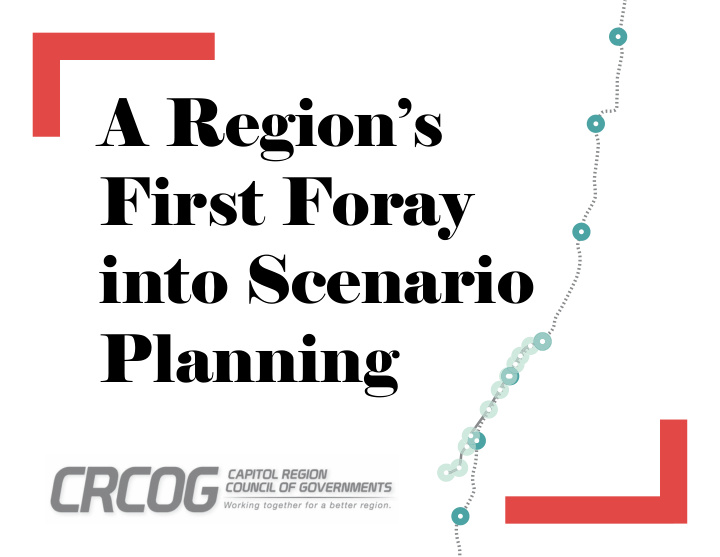



A Region’s First Foray into Scenario Planning
What is Scenario Planning? Scenario planning is a strategic planning method that organizations and communities can use to plan for an uncertain future by exploring the possibilities of what might happen. By considering various futures we can more effectively plan, make policies, and respond to the unknown.
Project Timeline
Existing Conditions Population Density Employment Density (973,960 Total) (496,703 Total)
Existing Conditions ~100 miles from Boston and NYC 4 existing + 3 planned CT rail stations 11 CT fastrak stations CT transit Local + Express bus service 2 major interstates
General Question: Based on our region’s 2045 projections for population + employment growth, what are potential consequences of various land use patterns and transportation investments?
Meet our Urban Footprint Scenarios BASE - Urban Footprint existing conditions THE LAND OF STEADY HABITS - Growth for region applied in the manner in which it is projected by CTDOT (2045) MARKET READY TOD - Growth focused along transit corridors - CTfastrak and CTrail - utilizing the CRCOG Sustainable Land Use Code for varying station area types on “soft” parcels MAXIMUM TOD - 100% of 2045 projected growth focused along transit corridors
Meet our Urban Footprint Scenarios Population + employment Population + employment 100% of population + distributed across the region as growth focused in corridors per employment growth focused per State projections. model land use code. in corridors per model land use code. “Remainder” of growth (what didn’t fjt along the corridor) No “remainder” allocated distributed across the region elsewhere in the region. proportionally, relative to State projections.
Urban Footprint Process Created unique “Development Types” in UF to refmect the recommended land use intensities recommended in the CRCOG “Sustainable Land Use Model Code”
Urban Footprint Process Painted these at the parcel level and checked them for appropriate + consistent of use of Development Types. First “painting” attempt with model code Revised and left Downtown New Britain as Development Types. “Urban” station area and repainted station to the east as “Suburban” and better defjned core and ring areas.
Urban Footprint Results
Urban Footprint Results
Meet our Travel Demand Model Scenarios PLANNED TRANSPORTATION NETWORK Includes multiple transportation projects approved in our Metropolitan Transportation Plan HIGHWAY IMPROVEMENTS Includes I-84 viaduct and I-84/I-91 interchange TRANSIT IMPROVEMENTS Includes various reduced headways for bus and rail HIGHWAY AND TRANSIT IMPROVEMENTS Includes improvements from both the highway and transit scenarios
CRCOG Model Results “Land of Steady Habits” anticipates congestion associated with ~14% growth in Vehicle Miles Traveled (VMT). Paired with Highway Improvements, congestion growth is appreciably lowered and VMT and is very slightly increased Paired with Transit Improvements, VMT and congestion growth are each lowered slightly
CRCOG Model Results Identifjed TOD scenarios most signifjcantly reduced regional growth in VMT and congestion Unintended congestion can result if appropriate infrastructure is not provided in TOD areas Although not as signifjcantly as “Land of Steady Habits,” all tested Scenarios appear to increase both VMT and congestion compared to existing conditions
CRCOG Model Results Regional Ridership increases from Transit Improvements and TOD scenarios. However, Transit is not anticipated to exceed 5% of mode share
CRCOG Model Results Transit Ridership was about equally sensitive to the identifjed Land Use and Transit Service Improvements Transit Work Trip Mode Share increases approaching CRCOG’s Urban Core
Potential Benefjts of TOD Scenarios: • Signifjcant reduction in redevelopment of greenfjelds lands (55% to 85%) • ~$100 million in household energy savings annually • ~10% reduction in roadway congestion (signifjcant reduction on freeways) • ~5% reduction in VHT (vehicle hours traveled) • ~3% reduction in VMT (vehicle miles traveled)
Next Steps Explore other regional scenarios • Population Growth • Transportation • Land Use Coordination with future CRCOG plans (MTP, POCD, CEDS, etc.) Offer scenario planning as a service to municipalities in our region, i.e. corridor studies, “district” or small area plans Refjne scenario planning methodology Look into additional tools... predictive land use models, population growth, employment growth, economic benefjts All Knowledge Corridor regional agencies on same platform
Thank You!
Recommend
More recommend